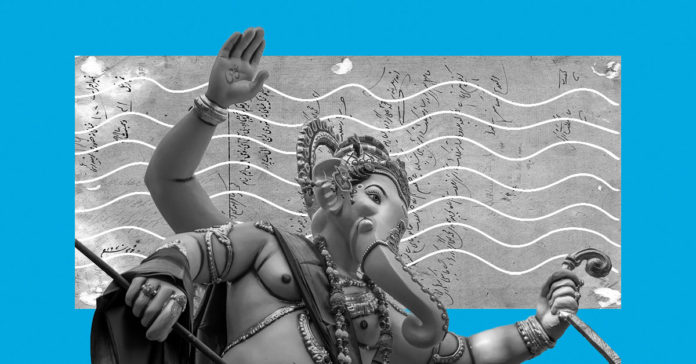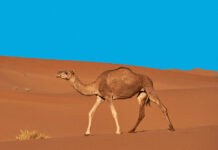Hindu deities are grouped under different categories based on their locality, physical features, character, vehicles, favourite arms, etc. Some of these groups are as mentioned below:
Local Deities: Bishwanath in Kashi; Sri Krishna in Boikunta; Kali at Kalighat; Jagannāth at Puri; Gayasura in Gaya; Basuki in patal (the nether world); Serpents in Nagalok; Varuna in water; Paban-deva in the air; sita (vagina) of Sati (wife of Siva) at Kamakhya; Mahadeva on banyan tree; Durga on asvaththa (Indian fig-tree); Krishna Tagore on kadam (tree); and Siva-Parvati on bilva (a kind of shell-fruit) tree. These and other local-based deities are called local deities.[1]
Special Physical Features: Chandra (the moon): tuberculosis; Shukracharya: one-eyed; Ganesa: elephant-headed; Indra: provided with thousand yoni (vagina), Ahallya: as solid as rock, Jotasura: jot (matted hair) in head, Narayana: like round stone, Brahma: four-faced and blood-coloured; Mahadeva: five-faced and white in colour, Durga: has ten hands; Jagannath: crippled limbs; Ganapathi: inflated belly, Chamunda: munda (head) in hand, Kali: black in colour, Krishna: sham (dark-colored). These and some other deities have special physical features.
Deities of Anger: Mahadeva: Out of anger he profusely urinated over the entire body of his father-in-law. Bhrigu: He hurt the chest of Bhagawän (god) with his leg. Parsurama: He eliminated the Kshatriyas (a Hindu caste) from this earth 21 times by hurting the earth with his axe. Gautama: He transformed Ahallya into a stone. He also created one thousand yoni (vagina) in the body of Indra. Durbasha: Cursing king Harish, he transformed him into a chandal (a man from the most inferior caste). Chamunda: She severed her own head from her body. Jahnumuni: He drank all water of the Ganges river. They did all these when they were angry. They are called deities of anger.
Deities of Love: Sri Krishna: He loved one thousand gopinis (milk-maids) in addition to Radha (wife of his maternal uncle), Lakshmi and Saraswati. Mahadeva: He became mad when tried to make love with Sati, earned Durga’s curse when made love with the Ganges river, and became too much confounded when he loved Parvati, daughter of the Himalayas. Narayana: He was transformed into rock when he loved Tulasi. Devaraj Indra: As a consequence of his love with Ahallya, one thousand yoni (vagina) grew in his body. Siva: He lost his linga (sex organ) as a consequence of making love with the wives of some sages. Jagai Madhai: Out of love for Krishna, they had complete apathy towards worldly affairs. Nimai: Out of love for Hari, he lost interest in worldly affairs. Menoka, Rati, Rambha: They distribute love everywhere. Madan: He is the king of love. Rati: She is the queen of love.
Deities of Fear: There are specified deities invoked for remedy of/protection from special type of danger. Some of these are as mentioned here: Manasa: for snake-bite: Jorasura: for fever; Shitala: for cholera and pox; Ite Kumar: for itching and skin disease; Durga: for any calamity, Ganesa: for losses in trade; Kartikeya: for enemies; and The Ganges: for drowning of the boat.
Vehicles: Rat for Ganesa, elephant for Indra, owl for Lakshmi, garuda (bird) for Krishna, peacock for Kartikeya, duck for Saraswati, ox for Mahadeva, lion for Durga, dog for Jamaraja, snake for Manasa, donkey for Shitala, dheki (indigenous machine for husking paddy) for Bishwakarma, and buffalo for Yama. These deities are called the Deities of Vehicles.
Arms: Trishul (trident) for Mahádeva, chakra (wheel) for Krishna, plough for Balarama, axe for Parsurama, arrow for Rama, shanka (shell) chakra, gada (club) and lotus for Narayana, dhanurban (bow and arrow) for Kartikeya, bajra (a weapon) for Indra, kharga (falchion) for Durga, gada (club) for Vhima, snake for Manasa. These and some other deities are remarkable for having arms and are called armed deities.
[Hinduism and Islam: A Comparative Study by Murtahin Billah Fazlie, p. 85-88]
Notes:
[1] For details about various categories of deities, see Bhattacharya, op. cit., pp. 64-66.









